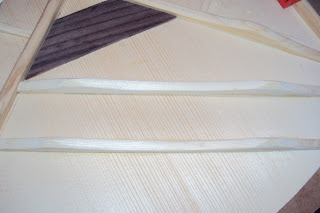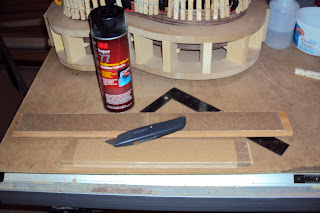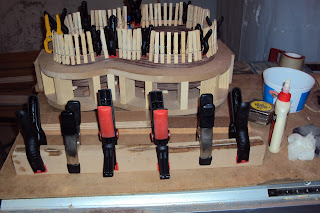Before I get too far into this step, I don't know if you noticed or not but I changed workbenches. My standard workbench is my table saw with a sheet of 1/2" MDF laid across it. I found, however, as I put in some long sessions that working above the mold so to speak, had me working at a height that became very uncomfortable for my back. I'm guessing but the table saw is around 32" tall and I have it on rollers so I can move it out of the way. The rollers probably add 2". The the mold is sitting on top of that. When I make saw horses the legs are 30" but considering the leg angle they're actually about 28" tall. That 6" makes all the difference in the world. So now I have two saw horses with an old formica kitchen counter clamped across that is about, I don't know, maybe 24" x 30" and it is perfect. I did roll out a piece of that no skid matrix - I don't know the technical name for it - as the formica is a little hard and slippery. You can see the set up in the second picture below as well as the table saw in the background.
The mold is a key player in this step. Ken's direction is to hold the top in place with a couple of rubber bands. This will allow me to tip the mold on edge so I can see what is going on underneath without the top slipping around. Placing a couple of finish nails at the front edge of the top will help it orient length wise before you rubber band. I pre-drilled the top, dropped in the nails, laid the board on the rims and that was when I first noticed this hole in the front where the rims abut. What the heck? I pulled the rim out of the mold. There was nothing poking that would have done this, no sharp edges on the mold, no nails or screw protuberences. All I could think is that while I was shifting the rims up and down in the mold to work on the soudboard or kerfing I must have caught a little sliver in the wood that pulled out more around it as I stressed it. No worries, the neck will cover it but disappointing to have a flaw that I will always know is there.
Now the rubber bands. Nothing fancy. Just looped together two or three cheap bands that come with your mail.Oh, I did have to loctate some screws for the bands to strectch across. I suppose you can do as many as you like. I just did these three feeling two diagonals and one cross was adequate - plus I ran out of rubberbands!!!
Now that I can hold the top on securely I can easily get inside the body to mark where the bracing intersects the rim. The rim and kerf lining will be trimmed out to let the bracing "nest" in the trimmed out area and the sound board will seat flush to the rims.
Prior to trimming the rims I sanded down the bracing so that where ever it would contact the rim it was only one popsicle stick tall (about 1/8" I think). This is critical because the binding will have to cover the thickness of the sound board plus the depth of this notch when it is installed.
This began a series of back and forth mark the rim, trim some out, test fit the bacing in the slot, sand down the bracing, mark again, trim again, test fit again. I was going very slowy and cautiously, especially in light of my two latest mishaps. I finally ended up with a nice fit. I was actually pretty pleased with the craftmenship on a couple and not so pleased on others - par for the course. One slot on the top edge is too long and too deep.I thought I would have to get creatiive but it looks like the binding will cover it well enough.
This one I like: These two I don't like:
 Great, the soundboard fits the rims nice and snug. Its time to glue and clamp. Remember the dry fit and test clamp routine. Absolutely critical here. You are gluing the entire soundboard all at once. I don't know about anyone else but as a first time acoustic builder I was very intimidated by this step. There is no return from even the slightest mishap here.
Great, the soundboard fits the rims nice and snug. Its time to glue and clamp. Remember the dry fit and test clamp routine. Absolutely critical here. You are gluing the entire soundboard all at once. I don't know about anyone else but as a first time acoustic builder I was very intimidated by this step. There is no return from even the slightest mishap here.The KMG kit provides a clamping caul for this operation. Its a piece of MDF cut oversize to the shape of the soundboard. You drill a series of holes (pre-marked) around the perimeter and this becomes the clamp as you drive a series of screws through the holes into the mold. As the screws tighten the caul presses the top and rim together. Go slowly and tighten the screws evenly and you will get a great result. Since I've gotten into this I have read a lot about this step in the process and I am aware that there are several methods to clamp the soundboard to the rim. While this method is extremely simple, it is totally practical. This has a great appeal to me as a New Englander and my appreciation for Yankee thrift (and I'm not talking baseball).
I was so nervous about this step that I went through the dry run process a few times. Snugging the sound board went smoothly and so did attaching the caul but because I was hand tightening the screws I was concerned that it was taking me way too long to finish. I wanted to try to get even pressure more quickly. On the second trial I used a combination of clamps and the screws.
I felt like that worked a lot better for me. Here is the final glue up and clamping.
The glue set overnight and then I used a trim bit in my laminate trimmer to flush the top and rim. I did the recommended clockwise step cuts first but did not take a pic of that.
Still a lot more sanding and clean up to do but this is the interior with the soundboard attached:
I am now up to 35 hours and feeling like quite the slow poke.
.JPG)
.JPG)







.JPG)
.JPG)
.JPG)



.JPG)






























